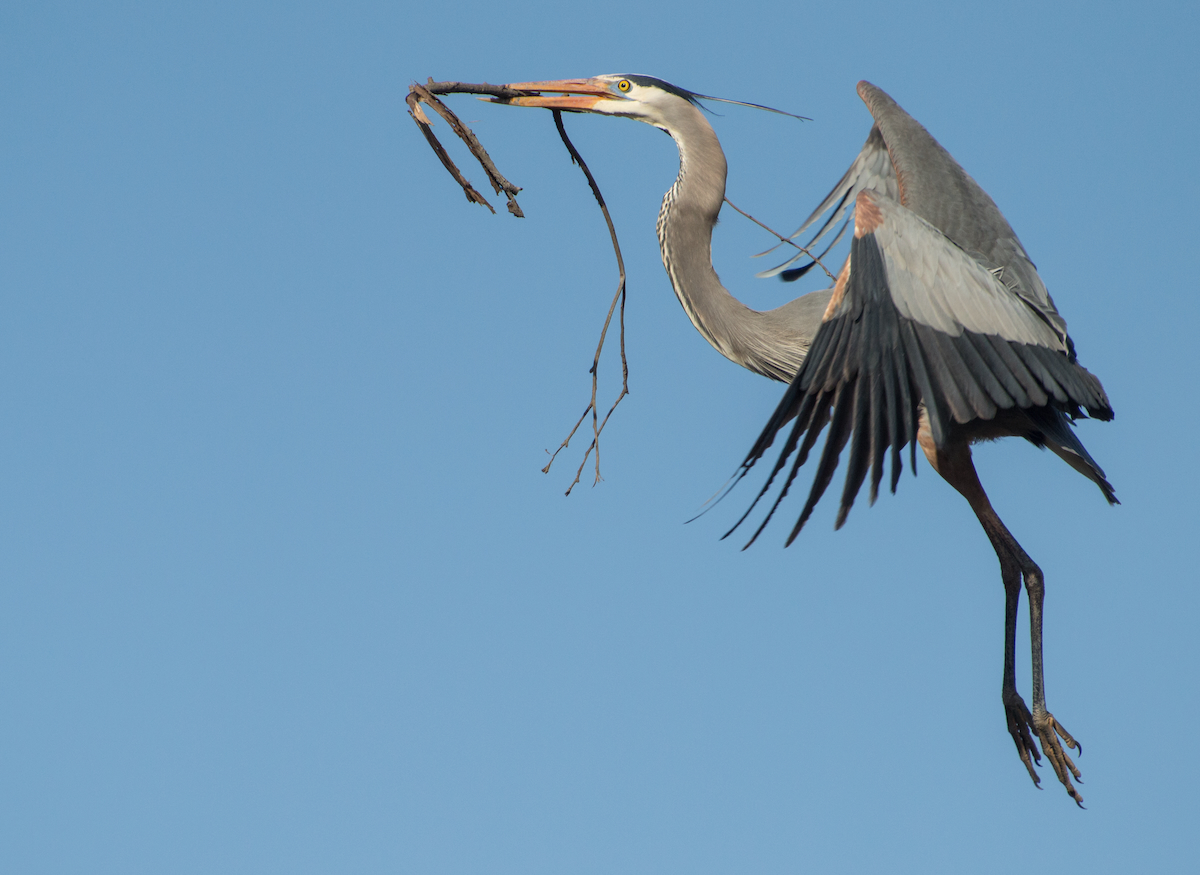
I have seen many moments in nature that exist at the threshold of impossibility. For the briefest flicker of time, gravity seems negotiable, a mere suggestion rather than law. I’ve spent decades attempting to capture these suspended instants—the split second when a bird is neither here nor there, but occupies some liminal space between intention and arrival.
Like this Great Blue Heron, caught in mid-flight against a perfect clear sky, carries with it not just the sticks of a future nest but the very essence of what draws me repeatedly to the water’s edge, waiting for these moments to photograph. The precise arrangement of its primary feathers, the mathematically perfect angle of its neck, the delicate grip of those prehistoric toes around gathered twigs—all of it existing for a heartbeat before disappearing forever.
The Buddhist concept of anicca—impermanence—is what I think of when I photograph birds. The understanding that nothing remains unchanged, that everything flows in constant transformation. For years I resisted this idea, my camera becoming a rebellion against time’s passage. If I could just capture enough perfect moments, perhaps I could construct some bulwark against impermanence.
At seventy, I now see my photographs differently. They are not dams against time’s river but rather stepping stones across it. Each image marks not an arrested moment but a connection between the woman I was when I pressed the shutter and the woman who now views the results.
When I photographed this heron a few years ago, I had been sitting for nearly three hours at the edge of pond. My legs had long since fallen asleep, and the morning’s coffee had become an increasingly urgent concern. I had almost—almost—convinced myself it was time to pack up and return home when I noticed this particular bird making repeated flights between a distant stand of pines and the collection of nests.
The physicist Carlo Rovelli writes that time is not what we think it is—not a universal flow but something that happens differently depending on where we are and how we move. I’ve experienced this temporal elasticity countless times in the field. Three hours can collapse into what feels like minutes when I’m fully absorbed in observation. This heron’s flight stretched one second into what felt like minutes as I tracked its path across my viewfinder.
The nest-building process possesses its own peculiar grammar. There is a syntax to how materials are selected, transported, and arranged. This heron with its carefully chosen sticks was composing a sentence in a language older than human speech. When we witness such moments, we are reading a text written in the evolutionary history of species that have been perfecting their craft across millions of years.
I wonder sometimes what the world looks like through a heron’s eyes. Their vision is adapted to cut through water’s reflective barrier, to spot the silver flash of fish beneath the surface. When they look at the sky, do they see what we see? Or do they perceive pathways and currents invisible to us, navigational markers embedded in the blue?
After decades of bird photography, I find my fascination not diminishing but deepening. The technical aspects—the settings, the equipment—have become nearly automatic. What remains is a growing sense of wonder at the extraordinary complexity and precision of these ancient creatures. Their lineage traces back to dinosaurs, yet they navigate our modern world with undiminished elegance.
This photograph captures more than just a bird in flight. It documents a creature between realms—no longer earthbound but not yet arrived, suspended in potential. There’s something profoundly hopeful in this image: the materials of creation clutched firmly, the wings spread in perfect balance, the destination known.
When I look at it now, years later, I’m reminded of something the poet Mary Oliver once asked: “Tell me, what is it you plan to do with your one wild and precious life?” This heron’s answer seems clear—to build, to create, to participate in the ancient cycle of regeneration.
And mine? To witness. To honor these moments with attention. To transform light into memory, and memory into sharing.
The architectural precision of flight. The mathematics of wings against sky. The gathered materials of a future home. All of this existing in a moment between moments, captured not just by a camera but by a lifetime spent learning to see.
Leave a Reply